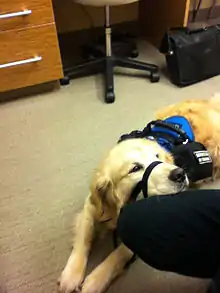Medical response dog
A medical response dog is a service dog trained to assist an individual who has a medical disability. Typically, they are dogs whose job does not handle primarily epilepsy or psychiatric-based conditions, though some seizure response dogs or psychiatric service dogs may also be referred to as medical response.

Many medical response dogs "alert" their handlers to conditions before they occur. For example, diabetes alert dogs partnered with diabetic persons may be trained to detect when the handler's blood sugar becomes too high or low.[1] In addition to or in the absence of this training, medical response dogs are also often trained skills to help in their handlers' symptoms, such as bringing medications or a telephone, providing bracing and other mobility assistance, or any other number of tasks.[2]
Many medical response dogs may be trained by an organization or by their handler. Like all assistance dogs, they must be of a particular work-loving personality and be properly socialized if expected to work in public. There are no breed or size restrictions other than those directly related to the tasks needed.
The allowed public accessibility of medical response dogs varies from region to region. In general, areas with laws protecting the usage of guide dogs and other assistance dogs, such as in the United States,[3] also cover medical response dogs as well.
See also
- Working dog – Dog used for work
References
- "Sniffing out diabetes and cancer". TIME Animals and Your Health: The Power of Pets to Heal our Pain, Help Us Cope, and Improve Our Well-Being. Time Inc. Books. 2016. ISBN 9781618938695.
- http://www.iaadp.org/psd_tasks.html A list of example tasks for psychiatric service dogs on the International Association of Assistance Dog Partners' website.
- "Archived copy". Archived from the original on 2007-08-20. Retrieved 2007-08-30.CS1 maint: archived copy as title (link) Americans with Disabilities Act of 1990